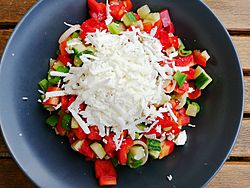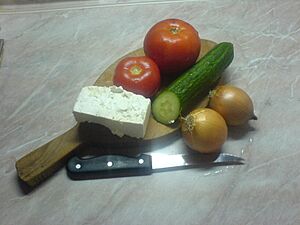Shopska salad facts for kids

Shopska salad as served in Bulgaria
|
|
| Alternative names | Bulgarian salad |
|---|---|
| Type | Salad |
| Place of origin | Bulgaria, Bulgarian Black Sea Coast, Druzhba resort |
| Region or state | Southeastern Europe |
| Main ingredients | Tomatoes, cucumbers, onions, peppers, sirene |
Shopska salad (called Шопска салата in Bulgarian, Macedonian, and Serbian) is a popular cold salad. You can find it all over Southeastern Europe. It is Bulgaria's most famous dish and its national salad. The colors of the salad even look like the Bulgarian flag!
Contents
What is Shopska Salad Made Of?
Shopska salad is made with fresh tomatoes, cucumbers, and onions. It also has raw or roasted peppers and sirene cheese. Sirene is a special white cheese that is kept in salty water. A little parsley is added too.
The vegetables are usually cut into small cubes. Then, they are lightly salted. A simple dressing of sunflower oil is added. Sometimes, a little vinegar is used, but sunflower oil is more traditional. The vinegar makes the salad taste a bit sour, just like the tomatoes.
In restaurants, the dressing often comes on the side. This lets you add as much as you like. Finally, a thick layer of grated or diced sirene cheese covers the vegetables. People often eat this salad as a starter with a drink called rakia.
How Was Shopska Salad Invented?
The Story of Its Creation
The name "Shopska salad" first appeared in a Bulgarian cookbook in 1940. But back then, it was for a different recipe, more like a spread called lyutenitsa. The salad we know today was actually created later.
It was invented in 1955 by a state tourism company called "Balkantourist". Even though the salad's name comes from a western Bulgarian area called Shopluk, it was first made in the eastern part of Bulgaria. This happened at a resort near Varna, on the Black Sea coast. The resort was called Druzhba.
The salad was part of a plan to promote tourism in Bulgaria. Petar Doychev, a very important person in Bulgarian tourism, helped make it popular. Shopska salad was one of several new salads created at that time. Other salads were named after different regions, like Dobrujan or Thracian. But only Shopska salad became famous and lasted.
Why the Colors Matter
The ingredients for Shopska salad were chosen carefully. They look like the three colors of the Bulgarian flag. This was done to make people feel proud of their country.
At first, the salad was a symbol for Bulgarian tourism. By the 1970s and 1980s, it became an official national food symbol. In 2014, Shopska salad was even voted Bulgaria's most recognized dish in Europe! This happened during a special event at the European Parliament called A Taste of Europe.
Who Invented Shopska Salad?
From Bulgaria, the recipe for Shopska salad spread to nearby countries. The Shopluk region, where the name comes from, is split between Bulgaria, Serbia, and North Macedonia. Because of this, some chefs in these countries started saying the salad was from their area. Some even claim it's from Croatia.
However, many experts agree it's Bulgarian. Miroslav Stefanović, a famous Serbian chef, says for sure that Shopska salad is Bulgarian. Also, in Romania, the salad is widely known as Bulgarian salad.
See also
 In Spanish: Ensalada Shopska para niños
In Spanish: Ensalada Shopska para niños



